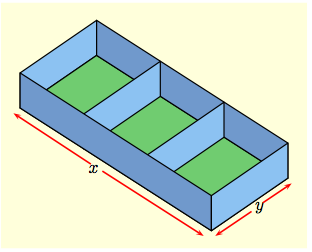Main page
Chapter 10: Parametric Equations and Polar Coordinates
Chapter 12: Vectors and the Geometry of Space
Chapter 13: Vector Functions
Chapter 14: Partial Derivatives
Learning module LM 14.1: Functions of 2 or 3 variables:
Learning module LM 14.3: Partial derivatives:
Learning module LM 14.4: Tangent planes and linear approximations:
Learning module LM 14.5: Differentiability and the chain rule:
Learning module LM 14.6: Gradients and directional derivatives:
Learning module LM 14.7: Local maxima and minima:
Maxima, minima and critical pointsClassifying critical points
Example problems
Linear regression
Learning module LM 14.8: Absolute maxima and Lagrange multipliers:
Chapter 15: Multiple Integrals
Example problems
|
Problem: the rectangular box shown to the right
has two parallel partitions but no top. It has a volume of $\,8$
cubic inches.
1. Express the amount, $A$, of material needed to construct the box as a function of the length $x$ and width $y$ of the box (assume no material is wasted). 2. Find the dimensions $x,\, y$ of the box that will require the least amount of material to be used in its construction. |
|
| Solution: 1. Let the height of the box be $z$ inches. Then the box has surface area $$A(x,\,y,\,z)\,\,=\,\, xy + 2xz + 4yz$$ because it has no top and two sides in the $x$-direction, while in the $y$-direction it has two parallel partitions as well as two sides. On the other hand, the box has volume $8$ cubic inches, which imposes a constraint condition: $$x y z \,\,=\,\,8, \qquad i.e., \ \ z\,\,=\,\, \frac{8}{xy}\,.$$ Eliminating $z$ from these equations gives $$A(x,\,y)\,\,=\,\, xy + \frac{16}{y}+ \frac{32}{x}\,.$$ This is the surface area as a function of $x,\,y$. We need to find its critical points. | 2. By partial differentiation: $$A_x\,\,=\,\,y - \frac{32}{x^2},\qquad\qquad A_y\,\,=\,\, x - \frac{16}{y^2}\,.$$ The critical points of $A$ thus occur when $$y\,\,=\,\, \frac{32}{x^2}, \qquad \qquad x\,\,=\,\, \frac{16}{y^2}\,,$$ i.e., at $(4,\,2)$. At this point $$A\,\,=\,\,A_{xx}\Big|_{(4,2)}\,\,=\,\, \frac{64}{x^3}\Big|_{x=4}\,\,=\,\,1\, > \,0,$$ $$C\,\,=\,\,A_{yy}\Big|_{(4,2)}\,\,=\,\, \frac{32}{y^3}\Big|_{y=2}\,\,=\,\,4\, > \,0,$$ while $$B\,\,=\,\,A_{xy}\Big|_{(4,2)}\,\,=\,\,1\, > \,0\,.$$ Thus $AC - B^2\,>\,0$ at the critical point. Consequently, the surface area is a minimum when $x = 4$ and $y=2$. |
